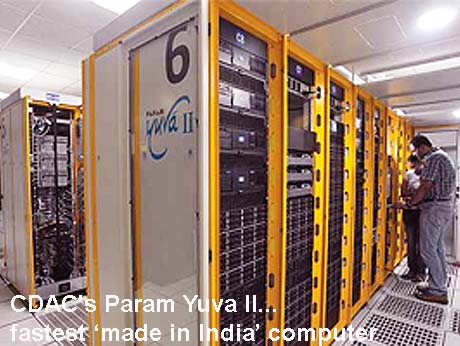
New Delhi, January 27 2014: The National Supercomputing Mission for India has set itself a short term, 3-year target, to set up three petaflop-scale facilities, networked into a grid. Twenty high end terra-scale facilities located in academic institutions, universities and research labs and 50 medium range terra-scale would also be created and networked.
The Mission's long term vision of making India a supercomputing power with exa-scale capability has been given a 7-year time frame and flows from a January 2012 decision to fund such an initiative with Rs 50 billion which today, is significantly shy of the $ 1 billion it bought at the time, thanks to the falling value of the rupee.
More interestingly, the mission announced by Prime Minister Manmohan Singh two years ago, "to build national capacity and capability in supercomputing" with this kitty -- widely understood as a direction to build an indigenous exascale computer -- seems to have been subtly reworked by the Scientific Advisory Council to the Prime Minister (SAC to PM) into what it calls a 'buy and build' approach.
This is borne out by the minutes of a November 2013 meeting of the SAC which have recently been posted on its website. While former Director General of the Centre for Development of Advanced Computing (CDAC), Dr Vijay Bhatkar, who was invited by the SAC to present his roadmap to achieve exascale capability is known to be a strong proponent of India building its own supercomputer, the centre of gravity for the national supercomputing mission, appears to have shifted ever so subtly to Bangalore, particularly to the Supercomputer Education & Research Centre of the Indian Institute of Science whose mantra hitherto has been to buy rather than build the systems it needed.
As it stands, the CDAC's Param Yuva II is the fastest made-in-India computer in the global Top 500 list of supercomputers clocking 520 tera flops which is just over half a peta flop. The other machine that is substantially made in India is the Eka at the Tata-funded Computational Research Laboratory in Pune ( 172 tera flops). All the other 10 India-based supercomputers in the last ( November 2013) Top 500 rankings including the fastest - a 790 tera flop IBM machine at the Institute of Tropical Meteorology, also in Pune -- are imported systems.
Last week the Advanced Numerical Research and Analysis Group (ANURAG) of the Defence Research and Development Organization, inaugurated the Dhruva-3 computer "a high-end facility very useful for the design of aircraft particularly Advanced Medium Combat Aircraft (AMCA) and other aircraft where we require analysis of aerodynamics at high speeds and under different conditions" according to DRDO head Avinash Chander. He added that it was "one of the fastest computing facilities in the country" but since ANURAG, characteristically did not say how fast, we have no way of knowing whether it is faster than Param Yuva II.
All this leaves the question still unanswered: in its quest to be an exascale supercomputing power by the end of this decade, is India going to design and develop her own supercomputer as her own experts have long urged -- or is she going to go on a shopping expedition, with something shy of a billion dollars jingling in her pocket? Or will it be a canny combo of make+buy?
Tech note: An exaflop is 1000 petaflops. The world's fastest machine today the Tianhe-2, a supercomputer developed by China’s National University of Defense Technology which clocks 33.86 peta flops. India's fastest indigenous computer, Param Yuva II clocks half a peta flop.